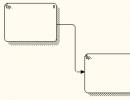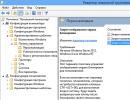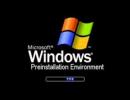Installing windows on macbook pro. Installing Windows on Mac
Installing one operating system side by side with another is standard practice in the computer industry. You can install both Mac OS on a Windows computer and vice versa. On our information portal you will find instructions for your computer. Below are detailed steps that will help you answer the question: how to install Windows on Mac?
Possible methods
To install the OS, you do not need special skills or professional help. Installing Windows 7 or 10 on Mac is carried out in the following ways:
- through ;
- Parallel Desktop program;
- built-in Bootcamp utility.
- Let's look at each case in more detail.
Using an emulator

To install Windows on a MacBook using this method, you need to download the free Virtual Box utility and install it. After that, follow the steps according to the instructions:
- launch Virtualbox;
- click the “Create” button;
- select the type and version of the operating system;
- determine the size of RAM that will be allocated for using the OS through the virtual machine;
- then click on “Create a new virtual hard disk”;
- select the virtual disk type and volume;
- then click the “Run” button;
- After the installation is complete, you will be able to install Windows on your Mac and use it.
How to install Windows on Macbook air or pro?

For the second method, you will need the Parallels Desktop utility. After downloading the program on Mac, follow the guide below:
- run the program;
- click the File button and select New from the context menu;
- then click install;
- select the installation source (image with the operating system);
- click the “Continue” button;
- in the new window, enter the software activation key;
- enter the name of the virtual machine and select the location;
- Click "Continue" to begin installation.
You can use either a free trial version or the full version of Parallela Desktop. For normal use of the software, the standard version is sufficient.
How to install Windows 10 on mac via Boot Camp?

With the help of BootCamp, Windows will be able to use all the resources of the Mac to the maximum, so this option is considered the most profitable and optimal. In the latest versions of Mac OS, this program is installed by default. Run the utility, first closing all running applications and open files:
- check the boxes next to “Download the latest software...” and “Install or remove Windows 7 or later”;
- click the “Continue” button;
- then select one of the options: make a copy of the support software to disk or save to external media;
- Next, set the size of the hard drive that will be used for Windows. For normal operation of the software, 20-30GB is enough;
- wait until the files are copied, after which the Mac will restart automatically;
- During reboot, press the Alt button to display a window with OS selection;
- select the Windows section;
- Now wait for the final installation and configure the settings.
Now you know how to install Windows 7, 8 or 10 on a macbook or imac. All the instructions described are suitable for any OS, starting with “seven” and newer.
Installation Features
After installation, you may encounter compatibility and driver problems. To fix this, you must download the drivers to a USB flash drive in advance, so that you can then install them on a clean OS.
Not long ago, Apple released a new generation of MacBook Pro laptops. The devices received, perhaps, the most significant update in the entire history of this series. And this is not only due to a significantly updated design (which is generally rare for Apple branded laptops), a completely new set of connectors and, of course, improved performance, but, above all, the appearance of an innovative control element: the Touch Bar with a Touch ID fingerprint scanner .
Traditionally, Apple is very conservative in the laptop segment. Having released one model, the company then updates only the hardware for several years - the processor and graphics accelerator. However, in 2015, the lineup was expanded with a 12-inch MacBook, essentially replacing the MacBook Air, and now it’s time for a radical rethink of the MacBook Pro concept.
It is, as always, difficult to find adequate competitors for the MacBook Pro on the market. Models that are more or less comparable in price tend to have lower performance. On the other hand, you can find Windows laptops similar in size and performance, but they will cost much more - it will be a completely different price category, and some characteristics will be noticeably better (screen resolution, for example), which is not always justified in such laptops.
Well, moreover, it is difficult to find a Windows laptop that would last as long on battery power as an Apple device. This is due, among other things, to the energy efficiency of the macOS operating system.
Installing Windows on Mac
It is very difficult to install the macOS operating system on a typical Windows computer, and even then it is not a fact that everything will work. In most cases, the so-called “Hackintosh” is used - a special build of macOS, which, after special rituals “with dances and tambourines”, can be launched on a regular PC. However, if the user is lucky with the motherboard, then after flashing the BIOS and replacing the bootloader, you can even install a completely official macOS distribution, which will even receive regular updates from the Apple server. Some, however, also call this method hackintosh.
But installing Windows on any Mac is a piece of cake. No more difficult than installing Windows on any “regular” computer, perhaps a little longer. The simplest method of installing Windows on a Mac is to use the Boot Camp Assistant utility built into macOS, which will help you partition the disk, configure the bootloader, and prepare a bootable USB flash drive with drivers and a distribution image.
Note that even if you prefer virtualization to installing multiple operating systems on your computer, this is also not a problem in macOS: the most popular virtual machine for Mac, Parallels Desktop (in which you can work with Windows applications and windows in the same way as with macOS) allows you to work with installed in Boot Camp Windows and does not require additional manipulations: that is, you can use Windows both in virtualization mode and by booting into it separately. But for the purposes of this article we will only work with Boot Camp.
So, we stock up on an external USB drive and a 16 GB flash drive. Now it's time to do something small - launch Boot Camp.
First, the utility will ask what we are going to do. Click the button to select an ISO disk image. Boot Camp will offer to use a flash drive to save drivers and other useful utilities that will be useful to us when working in Windows. The next stage is disk partitioning.
Usually programs that deal with disk partitioning are quite complicated for beginners, but here everything is elementary - you don’t have to do anything by hand. Maybe just pull the slider to choose how much space on the built-in storage will be allocated for macOS and how much for Windows. We were too lazy to choose, so we just clicked the “Divide into equal parts” button. To be honest, so to speak.
Basically, that's all. After clicking the “Install” button, Boot Camp will begin preparing the USB flash drive. At this time you can go have tea. Boot Camp will work for about half an hour, it all depends on how much you have to download from the Internet.
After Boot Camp finishes, the computer will reboot and Windows installation will begin as usual. Select a country, a keyboard, sit back, when selected, lean back again - and so on. Unless you have to manually format the newly created partition in NTFS. But Windows will warn you about this.
When Windows installs and finally boots, it will install the very same Windows support software from Apple that it includes.
Running Windows on Mac
How does Windows 10 perform on a MacBook Pro? Feels great. This is not surprising - the hardware of poppies is quite ordinary.
To help a Mac owner who has just left the friendly and familiar world of macOS and entered Windows - a world little familiar to him and therefore hostile, there is a “Boot Camp Control Panel”, which is automatically installed from a USB flash drive. The icon of this application is placed in the tray and you can always call it from there.
After installation is complete, you should open Windows Settings and download all system updates. The second step is to go to the application store and update the main programs. This will also take some time.
It is noteworthy that Windows 10 recommends using a resolution of 2560 x 1600 on the MacBook Pro. The Touch ID fingerprint scanner built into the Touch Bar refuses to work, since Apple has not released the appropriate drivers, and the touch panel itself will only offer a standard set of function keys: the capabilities of the Touch Bar are revealed only in macOS environment.
The trackpad panel in Windows 10 functions almost the same as in the Apple operating system. You can customize any gesture to perform a variety of actions with one, two, three, or four fingers. True, you cannot assign a three-finger press to launch Cortana.
By the way, the logical disk with macOS (which is formatted in HFS+) is also accessible from Windows. True, only for reading. You won't be able to delete anything from it, just like you won't be able to create a folder or file.
By the way, formatting will also not work - the system will throw an error. But it’s still better not to do this - if you try, it may crash and you will have to restore macOS via Recovery. From macOS, a Windows disk (formatted in NTFS) is also readable, but may not be writable.
Should I activate Windows or not?
It is worth understanding that there is nothing wrong if you do not activate Windows 10. Gone are the days when Windows scared users with a black desktop and activation reminders. There is now a watermark in the lower right corner of the screen that notifies you that the OS has failed activation.
For what reason did Microsoft decide not to seriously limit the functionality of the unlicensed version of the operating system? Nobody knows. The functionality of non-activated Windows 10 is practically unchanged. In this case, system personalization will not be available. This means that the user will not be able to change the theme color, desktop wallpaper and icons. In addition, the OS will not allow you to sync settings with another device. Otherwise, it will be a fully functional platform.
Download and select OS
On Mac there is no usual OS selection menu. By default, after installing Windows in Boot Camp, the laptop will boot into macOS without issue when rebooted or turned on. If you want to boot into Windows, you need to hold down the Alt button while booting - then a menu for selecting a boot partition will appear. If you haven’t installed anything else, there will be two partitions: macOS and Windows. Select the second one and boot into Windows.
And since Windows will reboot much more often than macOS, which generally rarely requires a reboot, it makes sense to configure the Boot Camp utility on Windows to boot into Windows by default. Even if you very rarely use Microsoft operating systems, believe me, it will be easier. After all, you will have to turn off or restart your Mac under macOS even less often.
Removing Windows from Mac
Without this paragraph, the article would not be complete. What should you do if you no longer need Windows on your Mac and need to remove it? Apple took care of this too. Boot into macOS, launch “Boot Camp Assistant” and select “Remove Windows 8 or later.”
That's it, nothing else is needed - the program itself will erase the disk partition that is no longer needed and fill the remaining space with the main partition.
Removing Windows has never been so fast - the entire procedure took less than a minute.
Bottom line
Practice shows that Apple still produces the best laptops in the world. Reliable, powerful, lightweight, energy efficient. But even if the Windows world doesn't let you go, all is not lost. Apple took care of the user and provided him with an amazing opportunity to use Windows on a Mac, if necessary.
If you have never reinstalled an operating system in your life, much less installed several operating systems on one computer, Boot Camp will still not let you get confused. You won’t even have time to get scared - a minimum of questions and Boot Camp will already start working. Well, if you are an experienced geek, then you will certainly be surprised by the simplicity and ease of the process. Although, it is worth noting that not every geek is able to appreciate the simplicity and ease.
With Apple's Boot Camp, you can boot your Mac natively into Microsoft Windows, without running two operating systems at the same time. This is largely useful for programs that do not run in Parallels virtual machines or VMWare Fusion.
Preparing to install Boot Camp
First, you need to make sure that all updates from Apple are installed:
- Go to the Boot Camp support page to see if there are updates for your model. Download and install if necessary;
- From the Apple menu, open Software Update and install all system updates;
- Be sure to create a backup!
Launching Boot Camp Assistant (for X 10.6 or later)
- Close all open applications, then in the Finder under Programs/Utilities, launch Boot Camp Assistant;
- Click Next to begin installation;
- If necessary, select Download the latest Windows support software from Apple;
- If necessary, enter the administrator password to begin downloading the software. Once the download is complete, save the files to your hard drive or USB.
Hard drive partition
Once the software download has finished, the Assistant will prompt you to create a partition for Windows on your hard drive. You will need to indicate how much free space will be allocated to this section. To install Windows 7 on a Mac, you will need at least 16 GB of free space.
Installing Windows on Mac
- Insert the Windows installation disc;
- Click the "Start Installation" button. The computer will restart and begin Windows installation;
- Follow the Windows Setup Wizard instructions;
- On the screen asking “Where do you want to install Windows?” select the BOOTCAMP section;
- Then select Disk Options (Advanced) and format the drive. It's better not to touch other settings.
Installing Windows Drivers
Once Windows is installed, you need to install the drivers that you downloaded earlier in order for all your hardware to work correctly in Windows, including sound, display, and wireless network adapters.
- Remove the Windows installation disc;
- Insert the flash drive or disk on which you previously recorded drivers for Windows;
- Browse the contents and in the Boot Camp folder, double-click setup.exe to install the drivers. Next, follow the onscreen instructions to complete the installation. Do not cancel the installation!
- After installation is complete, restart your computer.
Selecting an operating system to run
Your Mac now has both Windows and Mac OS X installed, and you can choose which operating system to use when you boot. Simply hold down the Option key when you turn on your computer or restart to open the selection menu.
Every user knows about Microsoft and Apple, which produce their own operating systems. But is it possible to install the familiar Windows 7 on a Mac produced by Apple? Of course, you can, because the latter even provide the necessary software. Next, we'll look at how to avoid mistakes and do it right.
Basic Mac Requirements
Before you install Windows 7 on Mac devices, make sure your computer meets the following requirements:- Internet connection;
- installed BootCampAssistant program;
- administrator account in Mac OS;
- working mouse/keyboard;
- at least 2 GB of RAM;
- 30 GB of hard drive space (more than 40 GB of space is recommended for additional applications and updates);
- if you will use a disc with an ISO image, you need a working DVD drive (external or internal);
- A USB flash drive or disk with 8 GB of free space (for installing third-party software, such as drivers);
- A Mac computer that supports the installation of an appropriate operating system.
Not every Mac computer model is suitable for Windows operating systems. This link shows the correspondence of operating systems and computer models from Apple https://support.apple.com/ru-ru/HT205016#tables
Before proceeding with the actual installation, you need to check whether this can be done in principle (link provided above). Only then plan subsequent installations. If the system is not supported, the installation will not occur. By clicking on the blue number (4 or 5) indicated in the table, you can download the required version of the BootCampAssistant application, ideal for installing Windows 7 on your existing computer.
Step-by-step installation instructions
Mac Air, Mac Pro, iMac, etc. are suitable for this process, the main thing is that all conditions are met. The installation procedure is as follows:
It is important to correctly select the disk partition that will be formatted before installation. It is a newly created program, just for the needs of a newly installed system, and is called BOOTCAMP.

Using a flash drive
If it is not possible to use a drive or there is no DVD with a system image, then you can write the image to a flash drive:
Video instructions for installing Windows 7 on Mac
We present to your attention a video that describes in detail all the steps for installing the Windows 7 operating system on Mac computers.





